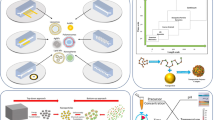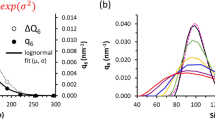Abstract
In this article, the term “physicochemical mechanism” is defined as a sequential series of steps culminating in the formation of a renal stone. Distinctions are drawn between physicochemical prerequisites for urinary supersaturation, crystallization, and stone formation. In particular, attention is focussed on the transition from crystal to stone. Emphasis is laid on crystal retention being the fundamental mechanism by which stones are formed, and mention is made of the different ways in which it can be achieved. The processes which dictate crystal-size enlargement, either during free particle flow or during fixed particle entrapment, are described. Modulators of these processes are classified in terms of their mode of action on particular steps in the mechanism rather than on their molecular weight or size. Three different approaches for describing stone formation mechanisms are summarized. These involve mathematical models, qualitative step-by-step pathways, and qualitative non-schematic descriptions. It is suggested that although physicochemical mechanisms are crucially involved in stone formation, they do so in concert with numerous other mechanistic processes, all of which are dictated by their own specific conditions.
Similar content being viewed by others
Abbreviations
- Bru:
-
Brushite
- CaP:
-
Calcium phosphate
- CaOx:
-
Calcium oxalate
- CF:
-
Crystal formation
- Cit:
-
Citrate
- GAGs:
-
Glycosaminoglycans
- Ox:
-
Oxalate
- Phy:
-
Phytate
- SF:
-
Stone formation
- UMM:
-
Urinary macromolecules
References
Finlayson B (1977) Calcium stones: some physical and clinical aspects. In: David DS (ed) Calcium metabolism in renal failure and nephrolithiasis. Wiley, New York, pp 337–382
Finlayson B (1978) Physicochemical aspects of urolithiasis. Kidney Int 13(5):344–360
Finlayson B, Reid F (1978) The expectation of free and fixed particles in urinary stone disease. Invest Urol 15(6):442–448
Blomen LJ, Bijvoet OL (1983) Physicochemical considerations in relation to urinary stone formation. World J Urol 1(3):119–125
Nancollas GH (1983) Crystallization theory relating to urinary stone formation. World J Urol 1(3):131–137
Kok DJ, Papapoulos SE (1993) Physicochemical considerations in the development and prevention of calcium oxalate urolithiasis. Bone and Mineral 20(1):1–5
Kok DJ, Khan SR (1994) Calcium oxalate nephrolithiasis, a free or fixed particle disease. Kidney Int 46(3):847–854
Hess B, Kok DJ (1996) Nucleation, growth and aggregation of stone-forming crystals. In: Coe FL, Favus MJ, Pak CYC, Parks JH, Preminger GM (eds) Kidney stones: medical and surgical management. Lippincott-Raven, Philadelphia, pp 3–32
Grases F, Costa-Bauzá A, Königsberger E, Königsberger LC (2000) Kinetic versus thermodynamic factors in calcium renal lithiasis. Int Urol Nephrol 32(1):19–27
Kavanagh JP (2010) Physicochemical aspects of uro-crystallization and stone formation. In: Preminger GM, Kavanagh JP (eds) Rao NP. Urinary tract stone disease Springer, London, pp 17–30
Bazin D, Daudon M, Combes C, Rey C (2012) Characterization and some physicochemical aspects of pathological microcalcifications. Chem Rev 112(10):5092–6120
Baumann JM, Affolter B (2014) From crystalluria to kidney stones, some physicochemical aspects of calcium nephrolithiasis. World J Nephrol 3(4):256–267
Nordin BE, Robertson WG (1966) Calcium phosphate and oxalate ion-products in normal and stone-forming urines. Br Med J 1:450–453
Robertson WG, Peacock M, Nordin BE (1968) Activity products in stone-forming and non-stone-forming urine. Clin Sci 34:579–594
Robertson WG, Peacock M, Heyburn PJ, Marshall DH, Clark PB (1978) Risk factors in calcium stone disease of the urinary tract. Br J Urol 50(7):449–454
Kavanagh JP (2006) Supersaturation and renal precipitation: the key to stone formation? Urol Res 34(2):81–85
Rodgers AL (2014) Urinary saturation: casual or causal risk factor in urolithiasis? BJU Int 114(1):104–110
Kok DJ, Papapoulos SE, Bijvoet OL (1986) Excessive crystal agglomeration with low citrate excretion in recurrent stone-formers. Lancet 327(8489):1056–1058
Kok DJ, Papapoulos SE, Blomen LJ, Bijvoet OL (1988) Modulation of Calcium-Oxalate Monohydrate crystallization kinetics in vitro. Kidney Int 34:346–350
Kok DJ, Papapoulos SE, Bijvoet OL (1990) Crystal agglomeration is a major element in calcium oxalate urinary stone formation. Kidney Int 37(1):51–56
Rodgers AL, Webber D, Hibberd B (2015) Experimental determination of multiple thermodynamic and kinetic risk factors for nephrolithiasis in the urine of healthy controls and calcium oxalate stone formers: does a universal discriminator exist? Urolithiasis 43(6):479–487
Fleisch H (1978) Inhibitors and promoters of stone formation. Kidney Int 13(5):361–371
Fleisch H (1979) Mechanisms of stone formation: role of promoters and inhibitors. Scand J Urol Nephrol 53(Suppl):53–66
Worcester EM (1994) Urinary calcium oxalate crystal growth inhibitors. J Am Soc Nephrol 5(5):S46–S53
Marangella M, Vitale C, Petrarulo M, Bagnis C, Bruno M, Ramello A (1999) Renal stones: from metabolic to physicochemical abnormalities. How useful are inhibitors? J Nephrol 13:S51–S60
Khan SR, Kok DJ (2004) Modulators of urinary stone formation. Front Biosci 9(629):1450–1482
Marangella M, Bagnis C, Bruno M, Vitale C, Petrarulo M, Ramello A (2004) Crystallization inhibitors in the pathophysiology and treatment of nephrolithiasis. Urologia Int 72(Suppl 1):6–10
Ryall RL (2010) The possible roles of inhibitors, promoters, and macromolecules in the formation of calcium kidney stones. In: Preminger GM, Kavanagh JP (eds) Rao NP. Urinary tract stone disease Springer, London, pp 31–60
Robertson WG, Peacock M, Nordin BE (1969) Calcium crystalluria in recurrent renal-stone formers. The Lancet 294(7610):21–24
Robertson WG (1969) Measurement of ionized calcium in biological fluids. Clin Chim Acta 24(1):149–157
Coe FL, Evan AP, Worcester EM, Lingeman JE (2010) Three pathways for human kidney stone formation. Urol Res 38(3):147–160
Rodgers A, Allie-Hamdulay S, Jackson G (2006) Therapeutic action of citrate in urolithiasis explained by chemical speciation: increase in pH is the determinant factor. Nephrol Dial Trans 21(2):361–369
Zhou JR, Erdman JW Jr (1995) Phytic acid in health and disease. Crit Rev Food Sci Nutr 35(6):495–508
Schwille PO, Schmiedl A, Herrmann U, Fan J, Gottlieb D, Manoharan M, Wipplinger J (1999) Magnesium, citrate, magnesium citrate and magnesium-alkali citrate as modulators of calcium oxalate crystallization in urine: observations in patients with recurrent idiopathic calcium urolithiasis. Urol Res 27(2):117–126
Rodgers A, Allie-Hamdulay S, Jackson G, Durbach I (2013) Theoretical modeling of the urinary supersaturation of calcium salts in healthy individuals and kidney stone patients: precursors, speciation and therapeutic protocols for decreasing its value. J Cryst Growth 382:67–74
Werness PG, Brown CM, Smith LH, Finlayson B (1985) EQUIL2: a BASIC computer program for the calculation of urinary saturation. J Urol 134(6):1242–1244
Yoshioka T, Koide T, Utsunomiya M, Itatani H, Oka T, Sonoda T (1989) Possible role of Tamm-Horsfall glycoprotein in calcium oxalate crystallization. Br J Urol 64:463–467
Hess B (1992) Tamm-Horsfall glycoprotein—inhibitor or promoter of calcium oxalate monohydrate crystallization processes? Urol Res 20:83–86
Wiessner JH, Hung LY, Mandel NS (2003) Crystal attachment to injured renal collecting duct cells: influence of urine proteins and pH. Kidney Int 63(4):1313–1320
Lieske JC, Leonard RE, Toback FG (1995) Adhesion of calcium oxalate monohydrate crystals to renal epithelial cells is inhibited by specific anions. Am J Physiol Renal Physiol 268(4):F604–F612
Grover PK, Thurgood LA, Wang T, Ryall RL (2010) The effects of intracrystalline and surface-bound proteins on the attachment of calcium oxalate monohydrate crystals to renal cells in undiluted human urine. BJU Int 105(5):708–715
Tsujihata M (2008) Mechanism of calcium oxalate renal stone formation and renal tubular cell injury. Int J Urol 15(2):115–120
Tiselius HG (2011) A hypothesis of calcium stone formation: an interpretation of stone research during the past decades. Urol Res 39(4):231–243
Aggarwal KP, Narula S, Kakkar M, Tandon C (2013) Nephrolithiasis: molecular mechanism of renal stone formation and the critical role played by modulators. Biomed Res Int 292953:1–21
Evan AP, Worcester EM, Coe FL, Williams J Jr, Lingeman JE (2015) Mechanisms of human kidney stone formation. Urolithiasis 43(1):19–32
Ratkalkar VN, Kleinman JG (2011) Mechanisms of stone formation. Clin Rev Bone Miner Metab 9(3–4):187–197
Acknowledgements
The author wishes to thank the South African National Research Foundation, the South African Medical research Council, and the University of Cape Town for financial support.
Author information
Authors and Affiliations
Corresponding author
Ethics declarations
Conflict of interest
The author declares that there is no conflict of interest.
Rights and permissions
About this article
Cite this article
Rodgers, A.L. Physicochemical mechanisms of stone formation. Urolithiasis 45, 27–32 (2017). https://doi.org/10.1007/s00240-016-0942-1
Received:
Accepted:
Published:
Issue Date:
DOI: https://doi.org/10.1007/s00240-016-0942-1




